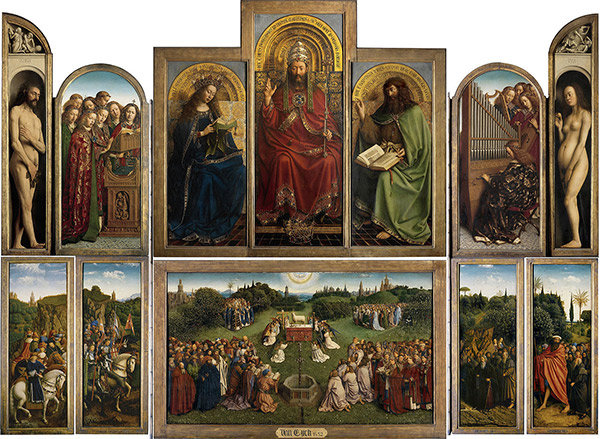Unveiled some 600 years ago at Saint Bavo’s Cathedral in Ghent, “The Adoration of the Mystic Lamb” by the Van Eyck brothers is one of the most stunning paintings to have survived from the European Renaissance. Having been split into pieces and stolen several times, the masterpiece has recently been the subject of a major conservation effort, which continues to this day.
Measuring nearly 15 by 10 feet, the size of Hubert and Jan Van Eyck’s altarpiece “The Adoration of the Mystic Lamb” is but one small element of what makes a lasting impression upon viewers. Painted in 1432 and popularly known as “The Ghent Altarpiece,” the massive painting is without debate one of the most important and extraordinary paintings to have survived since the Renaissance. Executed masterfully in the then-cutting-edge medium of oil paint, the painting displays a number of Biblical episodes in near life-size and in strongly saturated hues. Twelve panels composed the original work, which boasts several hinged doors to allow opening and closing.

Hubert and Jan Van Eyck, “The Ghent Altarpiece (detail of God the Father),” 1432
oil on panel, 15 x 10 ft. (c) Saint Bavo’s Cathedral 2016
Unfortunately, the painting’s importance and beauty has also made it a target for thievery. In fact, the altarpiece has been split into separate parts several times. What is more, parts of the painting were stolen by both Napoleon and the Nazis. On the eve of the Second World War, in 1934, two of the work’s 12 panels were stolen — presumably by the Nazis. Sadly, only one of these has been recovered. Earlier, the painting had to be hidden during the Reformation, as attacking Protestants would have defaced if not destroyed it. Nearly 200 years later, the panels were in the hands of Napoleon Bonaparte, who had seized them during his conquests of Europe. They were returned following Napoleon’s defeat at Waterloo.

Hubert and Jan Van Eyck, “The Ghent Altarpiece (detail from outter panel),” 1432
oil on panel, 15 x 10 ft. (c) Saint Bavo’s Cathedral 2016
Fortunately, the altarpiece —11 of its 12 panels — have survived the epic journey relatively unscathed, having finally been reunited, restored, and cleaned. The altarpiece has been the subject of a massive international conservation effort, begun in 2012, which focused exclusively on the exterior panels — which had naturally suffered the most wear. It was recently announced that restorers have finally begun to work on the interior panels, marking an important turning point in this epic journey.
To learn more, visit ArtDaily.
This article was featured in Fine Art Today, a weekly e-newsletter from Fine Art Connoisseur magazine. To start receiving Fine Art Today for free, click here.








